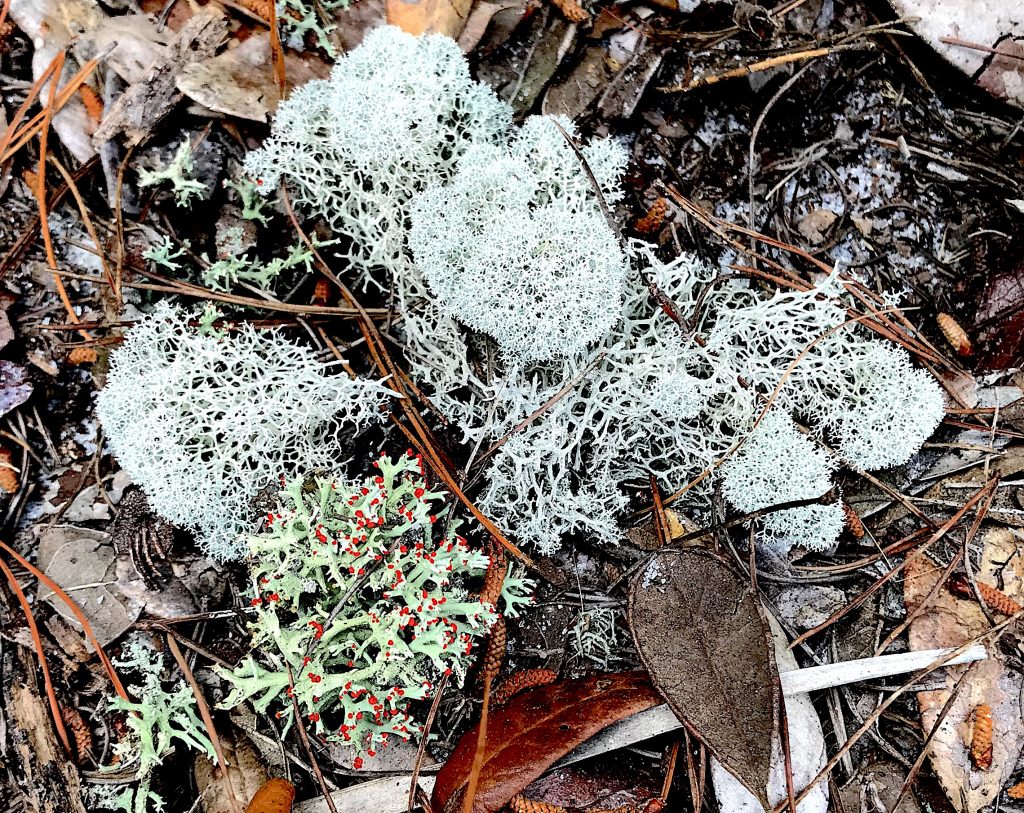
Reindeer Moss and British Soldiers. Photo by Green Deane
Cladonia is a large genus of edible but not tasty lichen. Two species are shown growing together (above photo.) It has kept many a creature alive in the winter time from moose to man. When I was a kid back in the BC era (before computers) there were acres of “British Soldiers” out in the woods behind our house in Maine. We’d clump through them making a crunching noise. Little did we know we were crushing centuries of growth. If you’ve taken any of my classes you known I’m positive about lichen. They don’t taste that good — most of them — and they need soaking to make them edible — most of them. But nearly all 17,000 of them are edible. They are a famine food and medicine available around the world and now out of this world. Lichen were among several organisms sent to the International Space Station and left outside for several months. The lichen survived and were the hardiest of the lot. You can read that story here. If you want to read more about the uses of lichen on earth here go here: Reindeer Moss, here and here.

Foraging classes are held rain or shine, heat or cold.
As I write it is 35 degrees Fahrenheit (1.6 Celsius) and a foraging class is the last thing on my evergreen mind. However, it will be warm by the weekend so the foraging will go on. I have a class in Port Charlotte (on a Saturday for a change) and in east Orlando Sunday. It might even warm up enough for shorts. See you there.
Saturday, January 25th, Bayshore Live Oak Park, Bayshore Drive. Port Charlotte. Meet at the parking lot at the intersection of Bayshore Road and Ganyard Street. 9 a.m. to noon.
Sunday, January 26th, Blanchard Park, 10501 Jay Blanchard Trail, Orlando, FL 32817. 9 a.m. Meet at the small pavilion next to the tennis courts near the YMCA building.
Saturday, February 1st, Dreher Park, 1200 Southern Blvd., West Palm Beach, 33405. 9 a.m. to noon. Meet just north of the Science Center.
Sunday, February 9th, Red Bug Slough Preserve, 5200 Beneva Road, Sarasota, FL, 34233. 9 a.m. to noon.
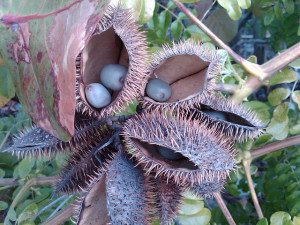
Nicker Beans are, technically, a climbing shrub.
Botany Builder #28: Echinate, covered with spines or prickles. It is from the Dead Latin echinatus, covered with prickles. Sea urchins are in the class of Echinoidea. “Urchin” by the way is an old word for porcupines as is hedgehogs. Mischievous boys are some times called urchins. Locally one medicinal plant is echinate, and that is the Nickerbean. Not a vine and not a tree, it is a “climbing shrub.” The Smilax is also not called a vine but a “climbing shrub.” The Nickerbean is not edible, but does, according to herbalists, have many medicinal applications. To read more about the Nickerbean go here.
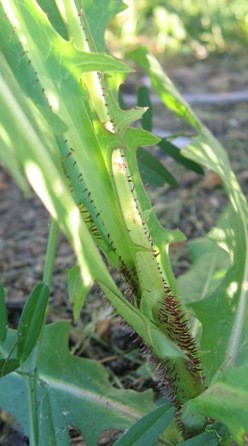
Prickly Lettuce has stiff hairs. Photo by Green Deane
Prickly not stingy: All four common wild lettuces* in Florida are coming into season including Prickly Lettuce. It isn’t seen too often in central Florida but I’ve found it on disturbed ground in the northern area of the state. Like most wild lettuce it is bitter but it has a distinct identification characteristic that makes it an easy forage-able. Like most lettuce it has a triangle-shaped leaf midrib and white sap. It also has on the back of the leaf midrib a single line of hair. However, on the Prickly Lettuce the line of hair is not wispy and fine but stiff and resistant, very easy to see and identify. Unlike rib hair on other lettuces this is a row of prickles and easily felt with by your fingers. The species grows rather rank and tall. Of course we want to pick it when it is young and tender adn even cooked it is bitter. To read a little more about the Prickly Lettuce, click here. *There are actually six wild lettuces reported in the state. The other three common ones are Florida Lettuce, Canadia Lettuce and Grass Leaf Lettuce. Two far more rare ones — and native to Tropical America — are L. mollis (rare in Franklin County) and L. intybacea (rare in the Miami-Dade and Monroe County area.) I do not know if those two are “edible.”
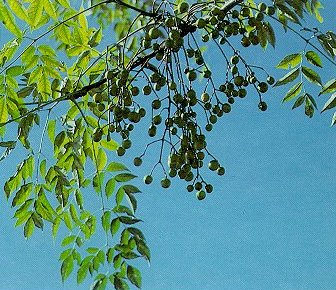
ChinaberryTree’s fruit is toxic.
A friend had to remove two trees from his elderly mother-in-law’s yard. She had just bought the house and was moving thus there were a lot of tax-payer supported busy bodies running around. Both of the trees are on the state’s hit list as invasive species. They are illegal to possess or transport. So, being a good citizen and dutiful son-in-law he cut them down and disposed of the trees. However after he cut them down the city told him he was subject to a $300 fine because he did not have a permit to cut the trees down. After the sawdust settled the city agreed to sell him an after-the-fact permit to cut down the banned trees but with a warning to get a permit in the future. While it was uncharacteristically reasonable of the city not be extreme about the issue it illustrates how fractured and irrational government can be. One entity insists action be taken (get rid of invasive species) and another penalizes you for taking that action (getting rid of invasive species.) Why people always want to expand government and give it more power is beyond my comprehension. Code Enforcement Boards (and homeowner associations) can make your life quite miserable.
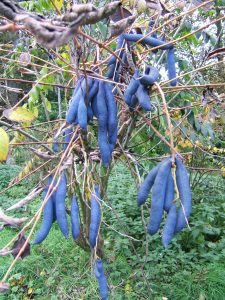
Dead Man’s Fingers
The endings of botanical names in Dead Latin can often give us a clue about the species especially -ifera and -oides (and variations such as -iferum.) Often the botanical name is virtually no help in identifying a plant, such as when the genus and the species honor two different people. A good example is Decaisnea fargesii,Dead Man’s Fingers. It’s named after Joseph Decaisne and Pere Farges. Bigelowia nuttallii is another example. No description there… seems like a lost opportunity to me… Sometimes the species name is misleading as the Longleaf Pine, Pinus palustris,which means a pine that likes to grow in swamps. Unfortunately Pinus palustris only grows on the top of dry sandy hills. That the descriptive name is very wrong is not enough to get it changed. The reason to change a name has to be botanical even if flimsy botanical.
ifera and -oides however usually are helpful. -ifera means “producing” or “bearing.” Papyrifera means paper bearing, as in Betula papyrifera, the Paper Birch, left. Bulbifera means bulb bearing, such as the Dioscorea bulbifera, the Air Potato. Cerifera means wax bearing like the Southern Wax Myrtle, Myrica cerifera. Myrica cerifera produces a green wax that was traditionally used to make Bayberry Candles.
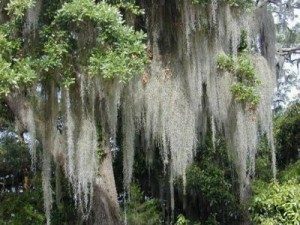
Spanish Moss
-oides means “resembling” or ‘looks like.”Tillandsia usneoides (Spanish Moss) means looks like the lichen Usnea. Ranunculoides means looks like ranunculus. Centruroides means … like sharp (and is also the genus of scorpions in reference to their stingers.) While the -folia can mean leaves it is also used to mean looks like. Aquifolium means holly-like leaves. Tiliifolia — yes four “i’s” — means basswood-like leaves. Sonchifolia means leaves like a sow thistle. So if you have an -ifera in front of you it should be producing something. If you have an -oides it should look like something else you probably already know. -Folia is usually also descriptive.
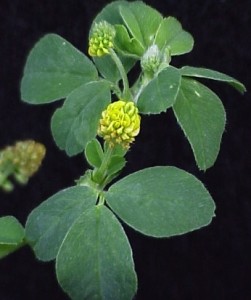
Black Medic
There quite a few species which at a quick glance from afar can look alike. Pellitory and Chickweed are two. The lichens Usnea and Ramalina two more. A couple of common plants that can look similar even at a close glance is Black Medic and Hop Clover (Medicago lupulina and Trifolium campestre.) Every season I have to remind myself which is which. Most often locally it is Black Medic. I am fond of saying there are no “look alikes” if you look closely enough. Black Medic and Hop Clover put that to the test. Hop Clover also looks like other clovers as well. It can be difficult to sort out. When the plants are in blossom a close look at the blossom is one clue. Hop clover’s petals come out from the center, widen, then bend down at the outer end. Black Medic’s blossoms open and fold up. They are also of a slightly different color: Gold yellow for the Hop Clover, lemon yellow for the Black Medic. The latter is also more furry. When both species have gone to seed quickest way to tell them apart is Black Medic’s seeds are black, Hop Clover’s brown. Also the middle leaf on the Black Medic has a slightly longer stem.
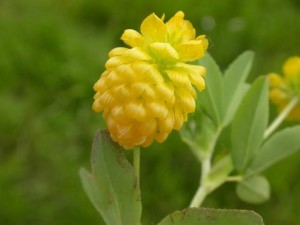
Hop Clover Blossom
To complicate issues there is also T. dubium, aka the Suckling Clover or the Lesser Trefoil. It looks similar to Hop Clover but has less petals and smaller blossoms. Its stems have a reddish tint. None of these species are on the top of the edible list but every little bit counts. Black Medic has also been called a Native American food which begs the definition some. Black Medic is from southern Europe or Eurasia. It came with the Europeans to North America. The first written reference to it in the New World is in 1807. There’s no ethnobotanical evidence the Europeans ate the seeds or any that the Native American’s ate the leaves.

Green Deane DVD set of 135 videos
Though your foraging may drop off during the winter it’s a great time to study wild edibles with my nine DVD set. Each DVDs has 15 videos for 135 in all. They make a great gift. Order today. Some of these videos are of better quality than my free ones on the Internet. They are the same videos but many people like to have their own copy. I burn and compile the sets myself so if you have any issues I handle them personally. There are no middle foragers. And I’m working on adding a tenth DVD. To learn more about the DVDs or to order them click here.

Green Deane Forum
Want to identify a plant? Perhaps you’re looking for a foraging reference? You might have a UFO, an Unidentified Flowering Object, you want identified. On the Green Deane Forum we — including Green Deane and others from around the world — chat about foraging all year. And it’s not just about warm-weather plants or just North American flora. Many nations share common weeds so there’s a lot to talk. There’s also more than weeds. The reference section has information for foraging around the world. There are also articles on food preservation, and forgotten skills from making bows to fermenting food.
This is weekly newsletter 389, If you want to subscribe to this free newsletter you can find the sign-up form in the menu at the top of the page.
To donate to the Green Deane Newsletter click here.

